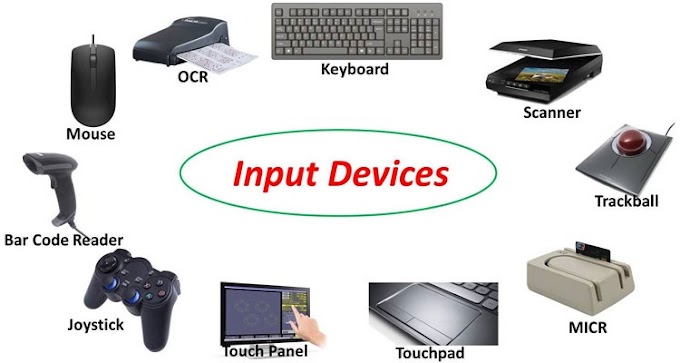Hard copy devices
Hard copy devices are used to draw a graphical image or other information onto the paper. Mainly two types of hard copy devices namely printers and plotters can be used to printing images, lines or characters onto paper.
Types of Printer
Many of the printing methods described in this section are now obsolete but are included for those interested in the history of computing technology!
- Line Printer
- Dot Matrix
- Daisy Wheel
- Ink-Jet
- Laser
- Camera Copy
Line Printer
Line printers have a spinning horizontal drum that stretches the full width of the paper which is separated from it by an inked ribbon. The drum is made up of 132 thin cylinders each having a complete set of characters. Behind the paper is a row of 132 hammers that strike the paper at the right moment to select the required character from the corresponding cylinder. In this way, it is able to print a complete line at a time. Line printers are used for high volume low quality output and are very noisy. They are obsolete now.
Dot Matrix
Dot matrix printers have a horizontally moving head with a vertical line of pins mounted inside. An inked ribbon is located between the head and the paper and as the head moves the pins strike the ribbon to form each character as a series of dots. The best quality printers have heads with 24 pins and low-quality ones have 9 pins (although by making two passes and shifting the head half a pin pitch between them they can effectively act as a 18-pin head). As these printers can produce small dots anywhere on paper most support graphics and have software fonts. Dot matrix printers are quite noisy but can be cheap. They are mostly for low to medium-quality, low-volume personal use. They are obsolete now.
Daisy Wheel
On a daisy-wheel printer, the complete set of characters is held on a removable wheel which consists of a central collar radiating out from which are a set of spokes, each ending in a single character. The wheel spins round to align the required character with a single hammer. The hammer and wheel assembly move across the paper striking it through an inked ribbon. These printers can produce high-quality output but are limited to the range of characters on the wheel. Changing wheels is simple, this provides alternative fonts but is no substitute if a wide range of fonts is required. They are quite noisy and are used for low-volume office work. They are obsolete now.
Ink-Jet
Inkjet printers have a movable head that can spray fine drops of ink directly onto the paper. Some have multiple heads carrying coloured inks with the best ones providing a wide range of colours. As the paper and the head never come into contact they are very quiet. However, they are also rather slow. They are generally cheaper than laser printers and are suitable for all types of high-quality low volume work. We have a few in the department including one colour Postscript and one CPS2.
Laser
In a laser printer, paper is given an electrostatic charge by passing it over a charged drum and then a laser scans it discharging all clear areas. Next, the paper is passed over a tray of powdered ink (toner) which is attracted to the charged areas. Finally, the ink is bonded to the paper by heat or pressure. Laser printers are quiet and are used for high quality low or high-volume work. We have a number in the department including PS9 (a Postscript printer near 615) and PS4 (a double-sided Postscript printer outside room 663).
Camera Copy
In this case, laser light writes directly onto film inside a camera to make high-quality full colour output. Again the process is expensive and the volume is low. OUCS have a camera copy service that takes Postscript format files.
Types of plotters
Plotter
A plotter is a special output device used to produce hardcopies of graphs and designs on paper. A plotter is typically used to print large-format graphs or maps such as construction maps, engineering drawings and big posters. Plotters are divided into two types:
1. Drum plotters
2. Flatbed plotters
Drum Plotter
A drum plotter is also known as Roller Plotter. It consists of a drum or roller on which a piece of paper is placed and the drum rotates back and forth to produce the graph on the paper. It also consists of a mechanical device known as a Robotic Drawing Arm that holds a set of coloured ink pens or pencils. The Robotic Drawing Arm moves side to side as the paper is rolled back and forth through the roller. In this way, a perfect graph or map is created on paper. This work is done under the control of the computer. Drum Plotters are used to produce continuous output, such as plotting earthquake activity.
Flatbed Plotter
A flatbed plotter is also known as a Table Plotter. It plots on paper that is spread and fixed over a rectangular flatbed table. The flatbed plotter uses two robotic drawing arms, each of which holds a set of coloured ink pens or pencils. The drawing arms move over the stationary paper and draw the graph on the paper. Typically, the plot size is equal to the area of a bed. The plot size may be 20- by-50 feet. It is used in the design of cars, ships, aircraft, buildings, highways etc. The flatbed plotter is very slow in drawing or printing graphs. The large and complicated drawing can take several hours to print. The main reason for the slow printing is the movement of mechanical devices.
Today, mechanical plotters have been replaced by thermal, electrostatic and inkjet plotters. These systems are faster and cheaper. They also produce large-size drawings.










No comments:
Post a Comment